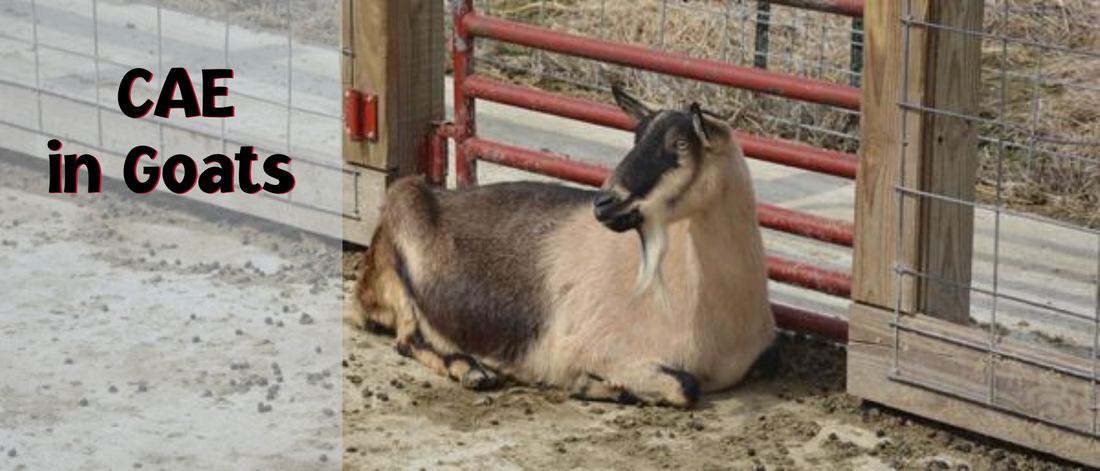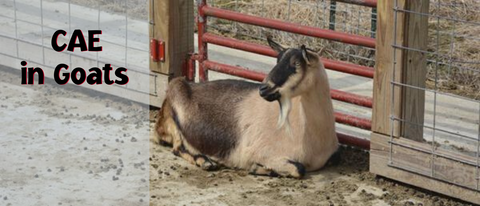
CAE in Goats
Share

CAE stands for Caprine Arthritis Encephalitis. It is a virus that affects goats and not humans. Goats pass CAE to each other via infected colostrum, milk, or blood. It is not passed from feces, breeding, or sharing food and water.
Should your Goat Herd Be CAE Free?
I don’t usually quote large sections of information from other sources, but I wanted people to be aware of the severity of CAE symptoms, so I’m directly quoting this information on the symptoms of CAE from the Veterinary Clinical Pathology Clerkship Program from the University of Georgia:
“Most goats infected with CAE virus are asymptomatic, but there are five major clinical presentations associated with viral infection including arthritis, encephalitis, interstitial pneumonia, mastitis, and progressive weight loss.9,16 The arthritic form of CAE viral infection is the most common manifestation of the disease and is generally observed in sexually mature goats (6 months and older).12,16 The arthritis tends to be chronic and progressive, though there have been reports of a sudden onset of lameness. Joints that are commonly affected (in descending prevalence) include: carpal joints, tarsal joints, stifle joints, fetlock joints, alantooccipital joint, and coxofemoral joints. All synovial membranes can be affected by CAE virus, and the number of joints affected in any one animal can vary. Early arthritic signs may be subtle or severe. Subtle signs include stiffness, shifting leg lameness, decreased ambulation, weight loss, reluctance to rise, and abnormal posture after rising. More severe arthritic signs can include acute swellings without pain upon palpation; joints that are drained of the fluid simply refill. Eventually these signs lead to a painful arthritis.
The encephalitic form of CAE viral infection most commonly affects kids between 2 and 6 months of age. The kids may show incoordination and inappropriate placement of limbs while standing and walking. A gradual paresis and paralysis, more commonly affecting the hindlimbs and often progressing to the forelimbs, can occur. Eventually, the animal is unable to rise to a standing position. If only the hindlimbs are affected, these kids have been seen to pull themselves around with their forelimbs. The kids can remain bright, alert, and responsive early in the disease process, but more commonly display additional neurologic deficits including depression, nystagmus, abnormal pupillary response, blindness, head tilt, head tremor, dysphagia, torticollis, circling, and facial nerve deficits. Affected kids are afebrile unless a secondary disease present.
CAE viral infection also can cause chronic interstitial pneumonia. Initially, a deep chronic cough can be observed. Later, chronic dyspnea, weight loss, tachypnea, and abnormal lung sounds can develop. It has also been noted that enlarged lymph nodes may contribute to some of the respiratory distress.
Mastitis, especially interstitial mastitis, is another form of CAE. Clinical signs include a firm, distended udder from which milk cannot be expressed. The mastitis usually is observed around parturition.
The final major form of CAE viral infection is chronic progressive weight loss. The progressive weight loss also can occur with any of the other forms of the disease.”
Watching any goat (but especially one you and your children love) develop these symptoms should convince you that CAE is a terrible disease. Fortunately, it is one that is easily prevented. To raise goats on CAE prevention means pulling the kids at birth and never allowing them to nurse from their dams. You must heat treat colostrum and pasteurize milk and bottle feed it to the kids.
Heat treating colostrum is a tedious and laborious process. You need to hold the colostrum at 135-140 degrees for 60 minutes. If the colostrum goes over this temperature, it will become pudding-like and be unusable. If it falls below 135 it will not effectively kill the CAE virus. We use a double boiler and make sure our thermometer is accurate. The larger the quantity of colostrum you are treating, the easier it is to maintain the temperature for the necessary time period.
Pasteurizing milk is much easier and involves bringing the milk to 165 degrees for 15 seconds. Be sure to cool both colostrum and milk to body temperature before feeding.
Testing for CAE is a very simple blood test. You can easily learn to pull blood yourself or have your vet do it. We pull blood periodically and send 5 cc’s of blood for each goat to Biotracking. They use the ELISA test, which is believed to be the most accurate. Biotracking tests this blood for CAE and can also do a pregnancy test on the same blood sample (on female goats) at the same time. CAE testing currently costs just $4 per goat, so it is pretty cheap.
When purchasing a new goat, ask to see the CAE results for the whole herd. Any responsible breeder with nothing to hide will gladly show you these results. If they have any CAE positive goats on their farm, they should be willing to disclose how they handle those goats. If there are no recent test results, require that blood be pulled and a test run before bringing the goat home.
We have learned from personal experience, that there are unscrupulous breeders who will intentionally lie to you about the CAE status of their herd. Unfortunately, this can be true even if the breeder seems nice and is friendly.
There are goat breeders out there who do not practice CAE prevention. They may believe that it is not humane to bottle raise or that CAE is not a real disease. They have every right to believe that and maintain their herd how they wish, but you do not want to start your life with goats with this disease. Start right and you won’t regret it. All you have to do is put down a favorite goat (or worse your child’s favorite goat) because they have become CAE symptomatic and you’ll forever regret not starting with a CAE free herd.
If you already have goats I would recommend testing them for CAE. Kids generally have to be older than 6 months before they can be tested. It is very easy to eradicate CAE from your herd. If any of your goats have CAE and are pregnant, I would recommend pulling their kids at birth and bottle raising them on CAE prevention. Cull any CAE positive goats from your herd.
If you have a herd that continually tests CAE free and is closed (no goats leave the farm or are brought in), then you can decide whether to dam raise or feed untreated colostrum and unpasteurized milk. Starting right will give you the option of doing this without the fear of passing on CAE to your new kids each year.

12/16/17 Update: We run a closed herd that has tested CAE negative for years. We still bottle raise, but feed colostrum and milk straight from the dam. We also no longer test the entire herd for CAE but randomly pick 2-3 goats each year to test for CAE.
Disclaimer: This information is provided as an example of how we personally raise goats at Goat Milk Stuff. We are not veterinarians and any information on the GMS website should not be taken as veterinary advice. Please seek the advice of a professional vet before making any changes to your herd management or individual treatment of your goat.